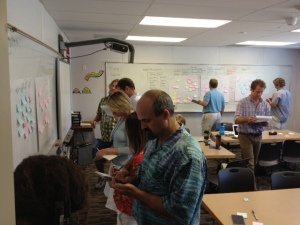If we truly believe that all educators can and should be leaders, we need to develop those skills that bake “leadership ownership” into the dough of the whole organization. In my ongoing work with the leadership team at Pacific Ridge School, we got to do just that today, while testing some new tools I have developed to help align mission, action, strategy, and value.
 Since its inception, Pacific Ridge has valued their unique focus on global engagement, so I pushed the team to test just how well they are fully connected in an increasingly connected world. They are the first school to fill out my new Constructal Dashboard, a simple tool to find just how and where the key constituents of the school community are actually connected.
Since its inception, Pacific Ridge has valued their unique focus on global engagement, so I pushed the team to test just how well they are fully connected in an increasingly connected world. They are the first school to fill out my new Constructal Dashboard, a simple tool to find just how and where the key constituents of the school community are actually connected.
The team self-assessed their understanding of authority, ownership, and influence as team leaders of their respective grade levels and divisions. Do leaders and their teams agree on the reach, purpose, and outcomes of a team’s work? If not, how can we close that gap? How can we distribute influence and not dictate? By developing and sharing outlines of their personal team goals, we developed a wonderful list of common elements of a successful team of educators tailored to the mission of Pacific Ridge School.
 Teams will best balance freedom to innovate and alignment to overall goals when those overall goals, or the “exoskeleton” is clearly defined. Head of School Bob Ogle and Assistant Head Jennifer Bjornstad set the boundary conditions of what an effective team will look like, and within those boundaries, we went through a quick design thinking process to flesh out actual team goals. The group brainstormed and mapped framing questions and available resources, shared their ideas, gathered them in a gallery walk, and amplified each others’ focal points for effective team plans through a fast-paced round of brain-writing.
Teams will best balance freedom to innovate and alignment to overall goals when those overall goals, or the “exoskeleton” is clearly defined. Head of School Bob Ogle and Assistant Head Jennifer Bjornstad set the boundary conditions of what an effective team will look like, and within those boundaries, we went through a quick design thinking process to flesh out actual team goals. The group brainstormed and mapped framing questions and available resources, shared their ideas, gathered them in a gallery walk, and amplified each others’ focal points for effective team plans through a fast-paced round of brain-writing.
Finally, as with all effective thinking, we re-tested our conclusions through the filter of first assumptions. How well did our work and takeaways align back to the mission? Did we miss anything big? The group found they had developed some very concrete themes through which to articulate the mission this year, and a process of design they can use with their own teams of grade level teachers.
Great mornings’ work and great kick off for the year!



Leave A Comment